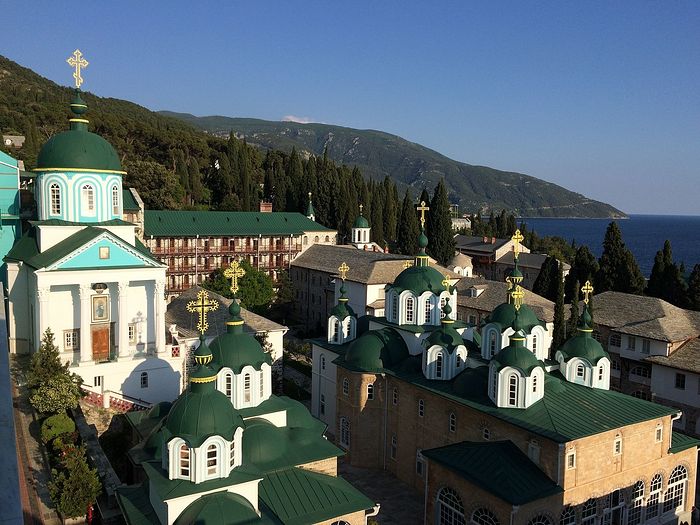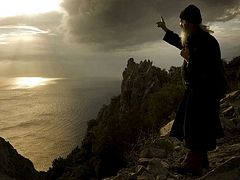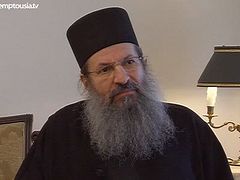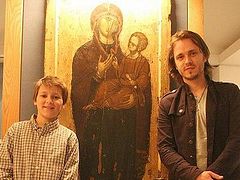Jonathan Dunne is an English Orthodox Christian living in Sofia, Bulgaria; his wife is the Bulgarian poet, Tsvetanka Elenkova. He received the Orthodox faith in 2012, and began his pilgrimages to Mt. Athos in 2013. A writer, Jonathan has been keeping meticulous and introspective notes, the result of which he has offered to us here in this essay on Mt. Athos.
For St. Ignatius the God-Bearer, who keeps me company in the Liturgy
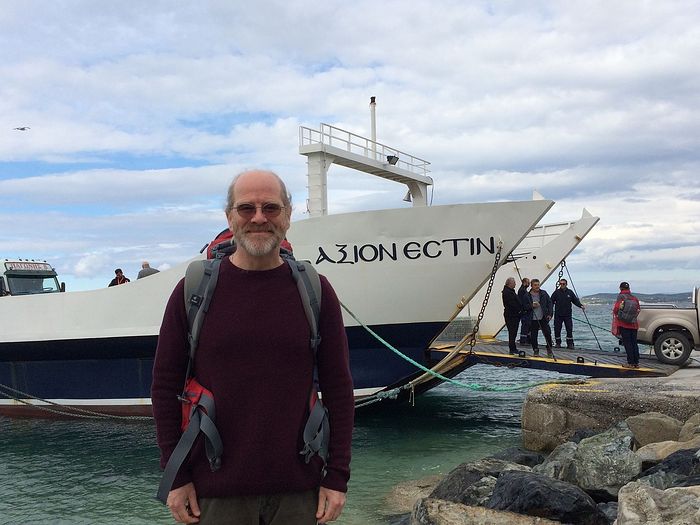 Jonathan waiting to board the Axion Estin ferryboat in Ouranoupoli
Jonathan waiting to board the Axion Estin ferryboat in Ouranoupoli
May 2019
DAY ONE
Ouranoupoli-Xenophontos Monastery
Letting go of the land. At quarter to ten in the morning. This is what we should be doing at quarter to ten every morning. Letting go of the land. Weighing anchor. Throwing off the moorings, the things that keep us tied to earthly concerns. Lifting up our age-old fears and letting the surge, the bubbliness, the salt of the sea dissipate them, blow them to pieces. Letting go of the land. Raising our voices in simple prayer. Lord, have mercy. Mother, save us. I awoke this morning, but didn’t really want to wake, my soul was land-bound, I wanted to sleep some more, I hadn’t slept enough after a long Sunday and a long drive the day before. I was earthbound. I preferred to get up in my own good time, serve myself (or be served) some creature comforts—breakfast, a comfortable chair—and let the day take its course with nothing untoward, nothing too demanding, nothing that would require me to make too much effort. I was afraid. Or a little grumpy. Keen to stay five days in the comfort of the room, to take little walks, not to be woken in the early hours of the morning, not to stumble into church in the dark, to bow before icons that were unfamiliar to me, before faces that were unfamiliar to me and almost indiscernible in the low light, to stay where I was, to put up a sign that said “Sorry, Closed”, “Not Here”, “Temporarily Absent”. The sight of the Pilgrims’ Office raised my spirits, put the smile back on my face that I had been wearing all day yesterday as we travelled down from Sofia, a smile that brought a similar smile to the faces of others, that lit up their expression, in the café of the petrol station they almost crowded around the counter to see us off, to wish us a good journey, they had little else to do, there weren’t too many people, they were able to take some time off to share a little human warmth. I was able to take a little time to share some human warmth. This is where we should be at quarter to ten in the morning. Letting go of the land. Heading south with the small island of Ammouliani behind us, Sithonia to the right, the jagged outline of Mt Athos, ancient arrowhead, draped in remnants of cloth, monks like clothes pegs on the line of the boat. I received a second, short shower at quarter to ten this morning—the wind blew water off the awning, sent a spray of drops over my back, my head, my rucksack, woke me up.
Xenophontos Monastery
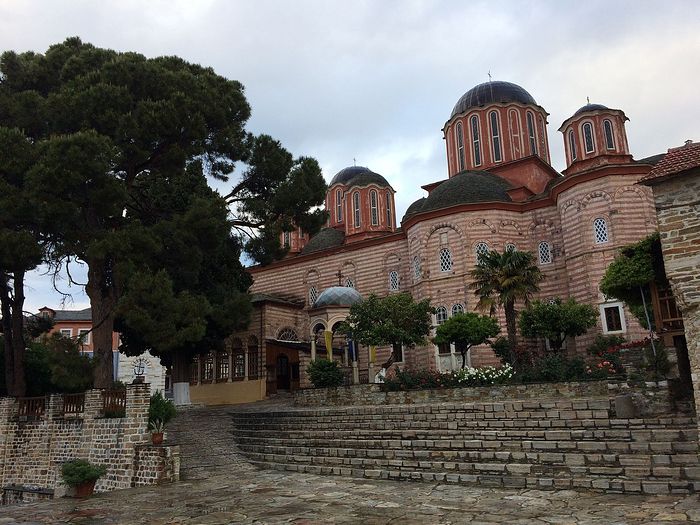 The katholicon at Xenophontos Monastery
The katholicon at Xenophontos Monastery
In front of an icon, certainly in front of a powerful icon, time slows down, almost grinds to a halt, and collides with eternity. This is what happened to me in front of the icon of the Mother and Child in Dochiariou Monastery, “She Who Is Quick to Hear”. When I prayed in front of this icon, I felt a wave of warmth, as if the Mother had responded immediately, eagerly, to my modest petition. Eternity (where she lives) crossed time (where I live), it reached its hand across the aisle, the street, the intervening space, and for a moment time forgot what it was about—forgot to count! This icon was previously on a wall of the refectory, and the monk in charge of the refectory, a monk called Nilus in the seventeenth century, would go about his business with a paraffin lamp that gave off black smoke, walking up and down in front of the image. The Mother kindly asked the monk to refrain from doing this as it was making the image sooty, but the monk was too busy to hear and continued walking up and down with the lamp until one day he went blind. The hapless monk fell to prayer and entreated the Mother to forgive his carelessness, which she duly did, restoring his sight to him. Meanwhile, the monks had the image moved to its current location, a small chapel to the right of the refectory entrance. This is considered one of the most important icons of the Mother and Child on Athos, together with the Axion Estin and the Portaitissa. I am travelling this time in the company of my eleven-year-old son, Gabriel. We waited for two hours in the guest house of the monastery to see if it would be possible to stay the night. When the guest-master appeared, he began to take down people’s details, Greeks first and then foreigners. There was a group from Georgia, a country I have great respect for and whose people I consider to bear royal blood in the line of their royal saints, David the Builder, Tamara and Ketevan. When it came to our turn, the guest-master turned to me and with mock seriousness said, “If you want to stay in the monastery, you have to cut your hair. Those are the rules.” I put my hand on his arm and said, “You’re joking.” Like many Orthodox, I have my hair tied in a medium ponytail. I suddenly realized that what I had taken as a stab at humour from this monk, who had served me in the gift shop only two hours earlier, was actually a bare statement of fact. If I wanted us to stay, I would have to take the kitchen scissors to my ponytail and chop it off. I looked around. Surely there would be other pilgrims with hair like mine? The people in the room suddenly looked—to a man—like army recruits. Except for the monks, of course. We continued to the next monastery along the coast, Xenophontos.
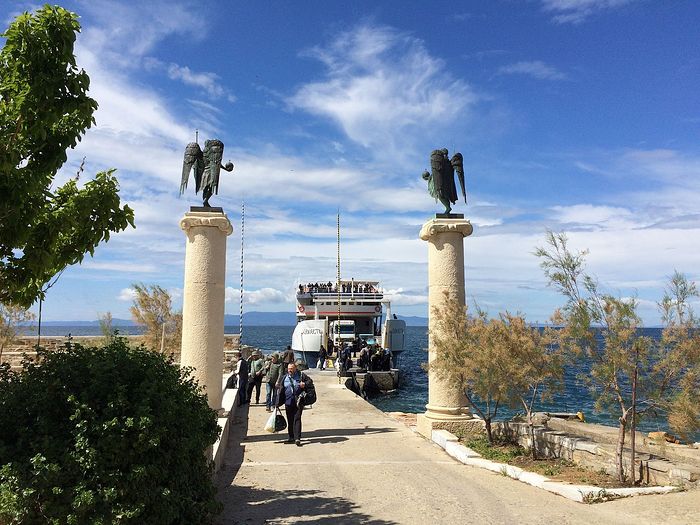 Arriving at Dochiariou Monastery
Arriving at Dochiariou Monastery
DAY TWO
Xenopohontos Monastery-St. Panteleimon’s Monastery
Whether or not I really had to cut my hair to stay in Dochiariou Monastery, I think there is a lesson there, and it began a little earlier when a tired and slightly sweaty pilgrim arrived in the guest house, which had suddenly become quite full, removed my son’s rucksack from the bench that lined the walls and placed it on top of mine. He then unwittingly sat on my son’s cap, which he obviously hadn’t noticed. I retrieved the cap, at which he barked, “Benches are for people, not bags,” and transferred my son’s rucksack to the floor. I felt a flash of anger. There had not been anyone sitting there earlier, the guesthouse had been half empty, and who was he to sit on my son’s cap and then chuck his rucksack on the floor? In one of those broken conversations in a language the other clearly doesn’t understand very well, in which your own English becomes faltering, I explained, “There were no people before.” But it doesn’t matter. The point is the man was tired, he was puffed out, having ascended the slope to the monastery. He needed a rest and, when he’d drunk a glass of water and downed a small glass of rakia, his mood improved enormously, he almost cooed when he offered my son the bowl of Turkish delight. It was the same with the guest-master. My initial reaction when I heard that we were not to stay—or I had to go to the kitchen and effect a quick chopping operation, my head on the wooden board, performing a kind of selfie by bringing the cleaver to bear down on my own hair, perhaps even using the selfie function on my phone to see what I was doing—was to be appalled, to burst into tears, to show him my son, whose first night on the mountain this was. But it doesn’t matter. They had their rules. Perhaps they didn’t want guests posing as monks, I don’t know. It was not God’s will for us to stay last night in that monastery, he wanted to bring us forwards, on to another monastery, Xenophontos, where the welcome was warm, where the fish at supper was one of the best I had tasted, where the coloured glass deposited beautiful prints on the wall of the exo-narthex in the afternoon light, where St. George seemed to dance in his gold frame inside the church, where the guest-master spoke beautiful schoolboy English and patted my son on the head and wished him to grow up to be an angel. The point was not to react, to have faith in God and his Mother, who brought us to this beautiful place where the birds chirp in the early hours of the morning and the ferryboats quilt the sea, go backwards in order to go forwards.
St. Panteleimon’s Monastery
The Russian monastery of St. Panteleimon is a thing of beauty. It is very distinctive from a boat because of the green, onion-shaped domes and the bell-cum-clock tower that stands above the refectory. It is dedicated to an early-fourth-century saint, Panteleimon, who is renowned for his healing powers, given to him by God. For this reason, he is usually depicted holding a compartmentalized box of medicines. He is a joyful saint. I have stood in the Russian church of St. Nicholas in Sofia when the relics of his skull were being brought from Mt Athos for local veneration, and first the monks carried in his icon, on which his face was a picture of radiance and childish glee. He seemed overjoyed to be in Sofia, and I shall never forget the happiness etched on his features, beaming from within. It was a pleasure to attend vespers in a church on the top floor of the main building (not in the main church, which stands in the middle of the courtyard). I am used to Russian services, having attended the Russian church in Sofia for three years, and can follow a service in Church Slavonic—which is, after all, Old Bulgarian, isn’t it?—better than in Greek. I also prefer the singing, which is clean and poignant, and doesn’t waver about so much as the Byzantine chant sung in Greek churches. I realize that Byzantine chant, which climbs and falls and tumbles about a single note, sometimes discordantly, has a haunting (troubling?) quality, but I find the singing in Russian churches more satisfying, more fulfilling, more peaceful. I still remember a recording of the Moscow Patriarchate Choir under Anatoli Grindenko in which the aim is for the choir to sound as one, as a single voice, and they achieve this to a remarkable degree. The Russians are a devout people, warm and direct. They have beautiful icons such as the Kazan Mother and Child (the original is lost, tragically burned by robbers to get at the valuable frame—little did they realize what it was they were chucking on the fire—and only copies of the original icon survive, some of them quite ancient). The Russians are keepers of the Orthodox faith—not the only ones, but their role is important—and it is a travesty of misinformation that we do not do more to learn from their practice. They are, after all, devout Christians belonging to an early Church—the Orthodox—that, thanks to the efforts and not infrequently the spilt blood of many, has kept the tradition of the Apostolic and Sub-Apostolic Fathers alive. This is of vital importance for the Church, for practising Christians, to be grafted on to the tradition (which occurs through the Sacrament of Chrismation) and to be aware at least of the Church Fathers, from Gregory the Theologian and John Chrysostom to Maximus the Confessor and Gregory Palamas, many of them writing in Greek, who established the faith.
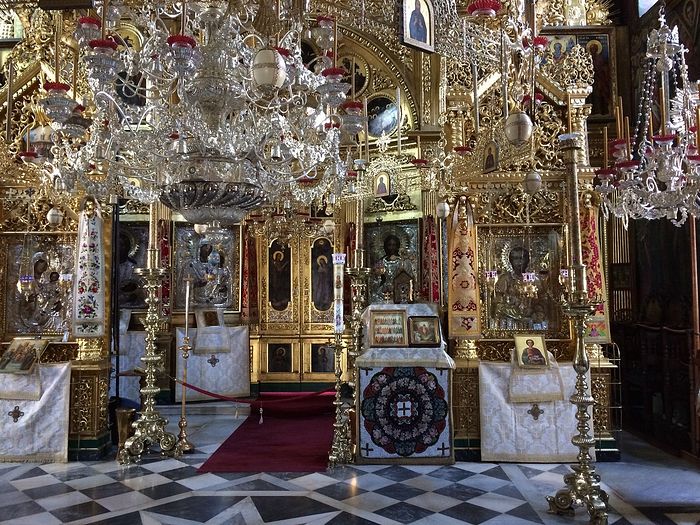 The interior of the katholikon of the Russian monastery
The interior of the katholikon of the Russian monastery
DAY THREE
St. Panteleimon’s Monastery-Koutloumousiou Monastery
Human life is a beeswax candle. It can vary depending on the thickness and the length. It is lit normally from another candle. Once lit, the wick burns red, bends to the side a little, and the flame rising above it is like an angel’s wings. When seen face on, and not in profile, the burning end of the wick is like the core of the earth, molten hot, the black space around it is like outer space, and this space is surrounded by a yellow flame—light, in short. This would imply that black space, what we see when we look up at night, is contained in the light, the warmth of which will scorch your hand if you place it above it. The candle is rooted to the ground, normally a candle stand, a candle holder or a spike. It burns slowly and gives off light. For the wick to burn, it relies on fuel, supplied by the beeswax, which melts just enough to feed the flame while the rest of the candle remains solid. This itself is a miracle—the pool of molten beeswax at the foot of the flame. This is convex, a bit like the dome of a Russian church, with the wick like a cross. As time passes, the candle burns down. It gets shorter and more humble. If it is attached to an upward-pointing spike, the end is very dramatic. The beeswax simply melts away, and there is no fuel left. Here comes the defining moment. When the beeswax melts away completely, there is a puff of smoke that trails up into the air, as if drawing the outline of a mountain range with jagged peaks or describing a growth forecast on a sales chart. The wick burns bright one last time, then it expires and collapses on the ground (the candle stand). All that is left is a remnant of wick. Nothing is left of the body of the candle, only the sinew, which must be wiped away with a cloth or picked up by a monk’s hand and deposited in the bucket for candle stubs. This is our life. We are given this chance to contain the universe—that is how gracious our God is. He allows us to burn unmolested. We may even be held by somebody saying a prayer in front of an icon—this is a boon, of course. But if the candle is held too long, it grows soft, it will curve, and then the flame that was upright and correct will begin to consume the beeswax—in effect, to bite the hand that feeds it—and the candle will splutter out. We must avoid this if we can. Another good surface for supporting the base of a candle is sand (see how similar the words are). Sand is porous and does not transmit heat like a human hand. The upturned spike is inserted into the base of the candle. This is our cross—it is what enables us to burn brightly.
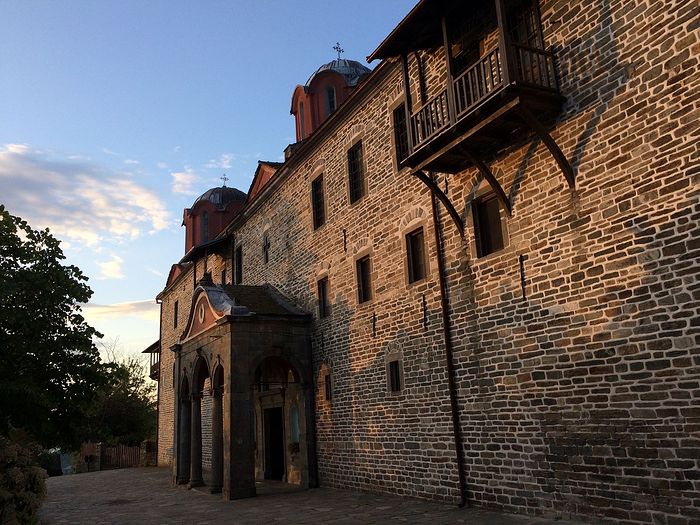 The front of Koutloumousiou Monastery
The front of Koutloumousiou Monastery
Koutloumousiou Monastery
Today was an eventful day, starting with the liturgy in the Church of the Holy Protection at the Russian monastery and ending with compline at Koutloumousiou. Today had everything in it that makes up a visit to Athos. A delicious breakfast of fried eggs and sweet noodles, hot tea with milk—truly this was a wonder and almost made me groan out loud—followed by veneration of the holy head of St. Panteleimon in the main church. We stripped our beds and then ambled down to the boatyard to await the arrival of the ferryboat Axion Estin. Gabriel worked on a Marvel quiz while I dozed in the shade of a tree, picking up some stowaways as I left, seed that would ride on my back in order perhaps to conquer another sunny patch of Mt Athos. A short boat ride to the main harbour, Dafni, a coffee and a soft drink as the water surged past and pilgrims recharged their phones at the few available plugs. We arrived in Dafni and quickly transferred to the bus for the journey to the capital, Karyes, past Xeropotamou, my last night on my previous trip to Athos, and up on to the ridge that runs down Athos like a backbone, glimpses of the arrowhead, the mountain itself, bare now of cloud for the first time this week, tantalizing views through the trees of the other side of the peninsula, the east coast, cells and hermitages dotted about like crumbs in the bread basket of the valley. On our arrival in Karyes, we venerated the icon of the Mother and Child, Axion Estin, in the Protaton Church, a wonderful sight, the Mother and Child a cut-out in the middle of the gilt frame, a heart cut from a cereal packet and hung in the window—it had been moved from its usual place behind the altar and now stood to the left of the iconostasis, catching me by surprise, teaching me never to think I know it all. Gabriel bought a torch in one of the shops, and we headed past the bakery to Koutloumousiou, again the arrowhead being sharpened on the horizon, a warm welcome, a short rest, and we took advantage of the time remaining before vespers to walk to the hermitage that was Elder Paisios’, Panagouda, where we entered the chapel and saw the chair in the corner he occupied with its black woollen back, his favourite icons next to him, in the corner where he could pray and sigh and rejoice as day all too suddenly lights the sky and the lid is taken off this world as God reaches down for a slice of bread, black or white.
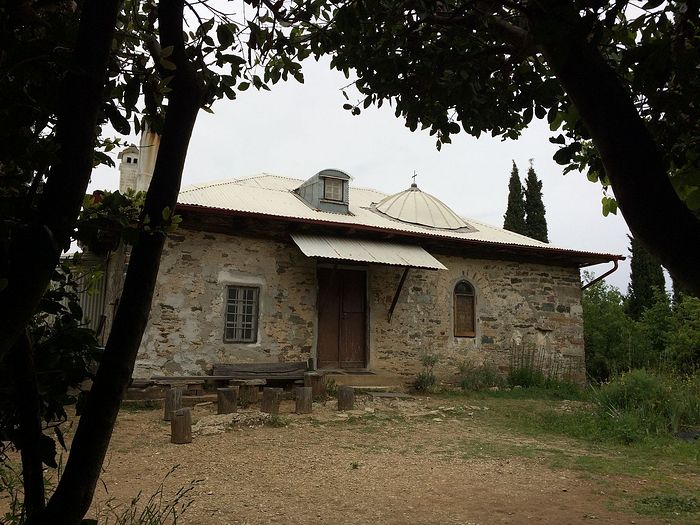 Panagouda, the cell of St. Paisios the Athonite
Panagouda, the cell of St. Paisios the Athonite
DAY FOUR
Koutloumousiou Monastery-Zographou Monastery
The head is a drop, and two drops are a heart. This is the essence of love. The drops are like comets trailing fire. Sparks. The essence of life. We are all sparks coming off a knife grinder’s wheel, flying in all sorts of directions, some climbing higher, others aiming lower, none of us lasting very long. A red bar that fizzles and expires. But in that moment, so much happens, so much warmth is generated. A spark can set fire to a carpet, a house, a whole town. A burning coal in a circle of black space that itself is surrounded by fire. When I walked into Karyes early this morning, only the bakery was working, the roar of a ventilator disturbing the silence. By the time I returned, the baker already had his wares set out, tray upon tray of large, crusty loaves. I had been told that the morning services in Koutloumousiou would not be in the main church, but in one of the chapels. However, I had forgotten to ask where. Some Greek pilgrims huddled in a corner of the courtyard, similarly confused. One of them was convinced the chapel was outside. I wandered around the courtyard, straining my ears for the faint sound of chanting, looking around for the tell-tale sign of burning candles, a few lights, but nothing, and no delayed monk to help us. Only the body of the church in the courtyard—the katholikon, as the main church in each Athonite monastery is known—temporarily moored in the harbour that is formed by the monastery’s four high walls. Four, note. There is no exit save by throwing off the moorings and rising into the sky. The birds squawk and squabble. They make quite a racket, actually. They are so busy! And have so much to say! They zoom past the main church building, showing how it’s done. It’s not so difficult, you just stretch out your wings and let go. Even the chicks will be out there soon, assaying their wings, but for now they content themselves with being fed. The church building is obdurate. If I tried to lift it up, I wouldn’t succeed. So I went to morning prayer in the Protaton Church instead. I sat a full forty minutes in front of the Axion Estin icon. I almost had her to myself! Then the monk threw us out, locked the door, mounted his tractor, we bowed to each other, and he drove off, exchanging a bit of banter with the baker, who stood proudly showing off his day’s work.
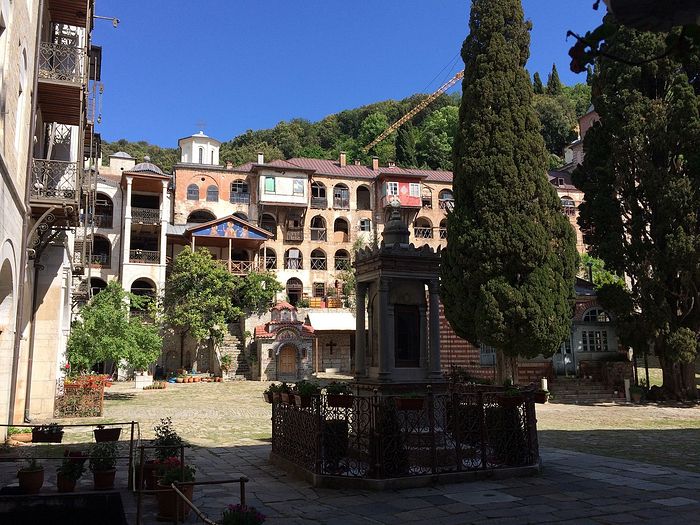 The monument to the twenty-six Zographou martyrs in the monastery courtyard
The monument to the twenty-six Zographou martyrs in the monastery courtyard
The end always comes, and tomorrow we will have a long drive. After we left Dafni on the Axion Estin ferry towards Zograf, I already began to feel that our time was drawing to a close and somehow part of you leaves ahead of time and part of you stays behind, like the light from a flame and a burning coal. And yet somehow this is false because Zograf, the Bulgarian monastery, captivated our attention, we were given a lift from the boatyard with two Bulgarian monks who didn’t realize I spoke Bulgarian and were a little surprised when we arrived and I spoke to them. A very respectful Italian travelled with us, an admirer of the architecture on Athos, and soon after we arrived we met a learned monk, Kalistrat, who later told me he had written a book on the architecture of Orthodox churches and how they should be built. The sound is important, but also, I think, the light—the light that creeps into the day on tiptoe, trying not to be seen; the light that sometimes floods our senses or crosses our line of vision, reminding us of its presence even when it is daytime. We entered the church for evening prayer, kissed the icons of St. George and the relics of saints that were set out in two glass cabinets. It is remarkable to read the works of saints such as Gregory the Theologian or Ignatius the God-Bearer—or the lives of the twenty-six Zograf martyrs who shut themselves in a tower and refused to come out and swear allegiance to the Pope, at which the tower was set on fire and only one who fell from the tower survived long enough to record what had happened—and then there are their bones, their physical presence, reaching through the centuries. St. Ignatius who went willingly to his death in the arena in Rome, where he was rent apart by wild beasts, and on his way to Rome, in chains, wrote seven letters to the fledgling churches in western Asia Minor at a time when people challenged the reality of whether God had truly gone to the Cross, had truly suffered. I spoke to another monk, Ioan, about the Church of the Holy Sepulchre in Jerusalem, the place where the two defining events of human history—the Crucifixion and the Resurrection—occurred, how welcoming it is, how humble its entrance. He gave me some oil from the lamp that burns in front of the icon of St. George and, when we left the church, said things will only go right in our lives when we follow the correct path and how doing the opposite only brings misery to ourselves and others.
DAY FIVE
Zographou Monastery-Sofia
 Jonathan and Gabriel outside Zographou Monastery
Jonathan and Gabriel outside Zographou Monastery
Man is a liturgical being. What does this mean? That he has need of prayer, but not prayer in isolation, he has need of corporate prayer, of the liturgy, the liturgy that is like the winding stem of a mechanical watch that needs to be wound up and then slowly unwinds as it clocks the passing of time and, if it is not then wound up again, will stop. The liturgy is not a uniform surface, it has its valleys and hills, its plains and grasslands, its deserts and rivers. It is musical. It has its crescendos and diminuendos, its accelerandos and rallentandos, like the heart, there is a surge towards the start of the liturgy that tells you something special is about to happen, we are about to wind the watch, we are about to enter the circuit that will bring us back to ourselves, that will realign us like a magnet. There is another moment in the liturgy when we pass from the Liturgy of the Word to the Liturgy of the Eucharist, the moment in the past when catechumens, candidates for baptism, would have been asked to leave the church, and a solemnity enters the air, the air becomes (for a moment perhaps) more parched, more rarefied, not the air we breathe as we lift up out of the water and take a deep breath that will propel us further, this is the air of a higher stratosphere, the air of mountain climbing, we cannot be so reliant on ourselves, we have entered a different environment where different biological rules apply. This is why we must climb slowly, we must enter the church when it is still dark, the change will be too abrupt, too sharp, for us if we go in unprepared, if we have not been sitting in the darkness, watching the flicker of the flames, the tick-tock of the yellow flames, counting time, playing games, and then arching upwards, sometimes out of control, sometimes they need to be tended, to be brought down a notch or two. You cannot go straight to the Liturgy of the Eucharist, to the sanctified gifts, to salvation; salvation is work, it must be acquired gradually, through the other (who is God; this is why other and theos—“God” in Greek—are only one letter apart). Love is the other; if you know your phonetics, you will know the pair l-r (and t-v is just a step in the alphabet). All that is left between love and other is breath, that rarefied substance that takes shape in the liturgy, oxygen—Christ—becomes solid food that we can take in through our mouths, and then the music catches up again, returns us to the normal rhythm, as the boat nudges up against the dock in Ouranoupoli, where a huddle of women is waiting expectantly, a long drive remains, and the tension, the content, of Athos, the convex surface of the wax, is broken—like the bread—so it can be scattered far and wide.

